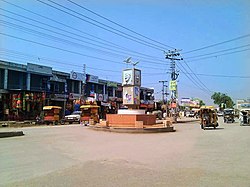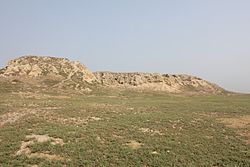Charsadda District, Pakistan
Charsadda District
ضلع چارسدہ چارسدې ولسوالۍ | |
|---|---|
 Charsadda District (red) inKhyber Pakhtunkhwa | |
| Country | |
| Province | |
| Division | Peshawar |
| Headquarters | Charsadda |
| Government | |
| • Type | District Administration |
| •Deputy Commissioner | Saad Hussain |
| • District Police Officer | N/A |
| • District Health Officer | N/A |
| Area | |
| • Total | 996 km2(385 sq mi) |
| Population | |
| • Total | 1,835,504 |
| • Density | 1,800/km2(4,800/sq mi) |
| •Urban | 292,396 |
| •Rural | 1,543,108 |
| Time zone | UTC+5(PST) |
| Number ofTehsils | 3 |
| Website | charsadda |
Charsadda District(Pashto:چارسدې ولسوالۍ,Urdu:ضلع چارسدہ) is adistrictin thePeshawar Divisionof theKhyber Pakhtunkhwaprovince ofPakistan.Prior to its establishment as a separate district in 1998, it was atehsilwithin thePeshawar District.[2]MohamedzaiPashtunsmake up the majority of the population of the district along with other minor tribes settled as well such as Uthmankhel, Mohmand, Kakakhel, Khattak. The district headquarter is the town ofCharsadda,which was once part of thePeshawarex-metropolitan region.
Overview and history
[edit]The district lies between 34-03' and 34-38' north latitudes and 71-28' and 71-53' east longitudes. Charsadda is located in the west of theKhyber Pakhtunkhwaand is bounded by theMalakand Districtto the north,Mardan districtto the east,NowsheraandPeshawardistricts to the south andMohmand districtto the west. The district covers an area of 996 square kilometers.
Charsadda was once part of the kingdom ofGandhara.However, around 516 BC Gandhara became part of the seventhsatrapyor province of theAchaemenid Empireand paid tribute toDarius the Great of Persia,until it was overthrown byAlexander the Greatin the 4th century BC.
After the death of Alexander in 323 BC, the Indian EmperorChandragupta Mauryarose to power and brought Gandhara under his sway. According to a popular tradition, EmperorAshokabuilt one of his stupas there.[citation needed]Actually, there were two stupas built by Ashoka, mentioned by the famous Chinese Buddhist pilgrimHieun Tsang,who visited it in 630 AD. Both were near the town of Po-Lu-Sha, one was outside the eastern gate of the town, and the other 20 li (10 km) northeast of it, on the mount Dantaloka.[3]
To the east, aBrahminicaltemple stood while to the north, a monastery was located. According to Buddhists, this monastery was the place whereBuddhapreached the Law. The name Gandhara went out of usage afterMahmud of Ghazniconquered the areaand converted it to Islam in 1026.[citation needed]
Bactrian Greeks
[edit]This area was also ruled by theBactrian Greeksbetween 250–125 BC which was succeeded by theIndo-Greek Kingdomwho ruled until 10 AD.
Shabqadar
[edit]Shabqadaris a tehsil within the District Charsadda. It is 17 miles (27 km) north west of Peshawar. A fort was built here by the Sikhs called Sharkargarh. The town was burnt by theMohmandsin 1897. It has since been rebuilt.[citation needed]
Bibi Syeda Dheri
[edit]Bibi Syeda Dheri is a site half a mile to the north of Umarzai village in Charsadda tehsil. At this location, a mound rises to a height of 60 ft (18 m). It is believed to be the site of the stupa erected to commemorate the conversion by Buddha of goddessHaritiwho used to devour children of the locality. There is also a shrine of a lady saint Bibi Syeda.[citation needed]
Shar-i-Napursan
[edit]Shar-i-Napursan is an archaeological site in Charsadda tehsil near the villageRajjar.Excavations have unearthed two distinct settlements of the Buddhist period and two of the Muslim period. Coins ofMenander,HermaeusandKanishkahave been unearthed.[4]
Palatu Dheri
[edit]
Palatu Dheri is another archaeological site near Charsadda tehsil. A mile from Shar-i-Napursan is a mound which contains the remains of a stupa, which according to Hieun Tsiang, was built by one Deven. Some coins which connect them both to the first century AD have been unearthed. Other finds include the image of the goddessKalika-devi.Three inscribed jars, which were presented by some laymen to "the Community of the Four Quarters", are now in thePeshawar Museum.[citation needed]
Charsadda
[edit]The city ofCharsaddaoriginally known asPushkalavatiis mentioned in the Hindu epic story theRamayana,where Bharata brings this new conquered city to one of his sons, Pushkala.[6]
Bala Hisar of Charsadda
[edit]Bala Hisarwas excavated twice by the head of theArchaeological Survey of India,Sir John Marshall,in 1902 and by SirMortimer Wheelerin 1958. According to the South Asian Archaeology Research Group ofBradford University,Wheeler suggested that Bala Hisar "was founded by the Persians in the sixth century BC as a colony guarding the eastern edge of their empire".[7]
Demographics
[edit]| Year | Pop. | ±% p.a. |
|---|---|---|
| 1951 | 282,618 | — |
| 1961 | 364,088 | +2.57% |
| 1972 | 513,193 | +3.17% |
| 1981 | 630,811 | +2.32% |
| 1998 | 1,022,364 | +2.88% |
| 2017 | 1,610,960 | +2.42% |
| 2023 | 1,835,504 | +2.20% |
| Sources:[8] | ||
As of the2023 census,Charsadda district has 263,934 households and a population of 1,835,504. The district has a sex ratio of 107.49 males to 100 females and a literacy rate of 53.94%: 66.55% for males and 40.36% for females. 542,879 (29.58% of the surveyed population) are under 10 years of age. 292,426 (15.93%) live in urban areas.[1]Pashtois the predominant language, spoken by 99.66% of the population.[9]
| Religion | 1941[10][a] | 2017[11] | 2023[12] | |||
|---|---|---|---|---|---|---|
| Pop. | % | Pop. | % | Pop. | % | |
| Islam |
239,634 | 98.11% | 1610087 | 99.95% | 1,830,646 | 99.76% |
| Hinduism |
2,533 | 1.04% | 38 | ~0% | 41 | ~0% |
| Sikhism |
1,940 | 0.79% | — | — | 14 | ~0% |
| Christianity |
127 | 0.05% | 518 | 0.03% | 4,392 | 0.24% |
| Others | 12 | 0.01% | 317 | 0.02% | 43 | ~0% |
| Total Population | 244,246 | 100% | 1610960 | 100% | 1,835,136[b] | 100% |
Administration
[edit]The district is administratively subdivided into 3Tehsilscomprising a total of 58Union Councils:[13]
| Tehsil | Urdu Name | Pashto Name | No. of Union Councils |
|---|---|---|---|
| Charsadda | تحصیل چارسدہ | چارسدې تحصیل | 34 |
| Tangi | تحصیل تنگی | تنګي تحصیل | 12 |
| Shabqadar | تحصیل شب قدر | شب قدر تحصیل | 12 |
National Assembly Seats
[edit]The district is represented in theNational Assemblyby two MNAs who represent the following constituencies:[14]
| Constituency | MNA | Party |
|---|---|---|
| NA-24 (Charsadda-I) | Vacant | |
| NA-25 (Charsadda-II) | Vacant |
Provincial Assembly Seats
[edit]The district is represented in theProvincial Assemblyby five MPAs who represent the following constituencies:[15]
| Member of Provincial Assembly | Party Affiliation | Constituency | Year |
|---|---|---|---|
| Khalid Khan | Pakistan Tehreek-e-Insaf | PK-59 (Charsadda-I) | 2018 |
| Shakeel Bashir Khan | Awami National Party | PK-60 (Charsadda-II) | |
| Sultan Mohammad Khan | Pakistan Tehreek-e-Insaf | PK-61 (Charsadda-III) | |
| Fazle Shakoor Khan | Pakistan Tehreek-e-Insaf | PK-62 (Charsadda-IV) | |
| Mohammad Arif | Pakistan Tehreek-e-Insaf | PK-63 (Charsadda-V) |
Towns and villages
[edit]- Sardheri
- Sukar
- Matta Mughal Khel
- Ambhader
- Daulat Pura
- Kangra
See also
[edit]References
[edit]- ^ab"7th Population and Housing Census - Detailed Results: Table 1"(PDF).www.pbscensus.gov.pk.Pakistan Bureau of Statistics.
- ^PCO 1998,p. 1.
- ^Beal, Samuel, (ed. & trans.), (1884).Si-yu-ki: Buddhist Records of the Wester World, Volume 1,Author: Huen Tsang,p. 112:"Outside the eastern gate of the town of Po-lu-sha is a sangharama with about fifty priests, who all study the Great Vehicle. Here is a stupa built by Asoka-raja [...] To the north-east of Po-lu-sha city about 20 li or so we come to Mount Dantaloka. Above a ridge of that mountain is a stupa built by Asoka-raja."
- ^Province (Pakistan), North-west Frontier (1931).N.-W.F. Province Gazetteers.p. 320.
- ^Problems of Chronology in Gandharan Artp.37
- ^Shastri, Hari Prasad, (1952)."Uttara-kanda, Chapter 101: The slaying of the Gandharvas and the conquest of their Country",in:The Ramayana of Valmiki:"Bharata, the son of Kaikeyi entered those two opulent and magnificent cities, and there, Bharata established Taksha in Takshashila and Pushkala in Pushkalavata, in the country of the Gandharvas, in the ravishing region of Gandhara."
- ^"Bradford University – The Bala Hisar of Charsadda".Archived fromthe originalon 13 December 2007.Retrieved16 June2007.
- ^"Population by administrative units 1951–1998"(PDF).Pakistan Bureau of Statistics.
- ^"7th Population and Housing Census - Detailed Results: Table 11"(PDF).Pakistan Bureau of Statistics.
- ^"CENSUS OF INDIA, 1941 VOLUME X NORTH-WEST FRONTIER PROVINCE".Retrieved14 October2021.
- ^"Pakistan Census 2017 District-Wise Tables: Charsadda".Pakistan Bureau of Statistics.
- ^"Pakistan Census 2023"(PDF).www.pbscensus.gov.pk.Pakistan Bureau of Statistics.
- ^Tehsils & Unions in the District of Charsada - Government of PakistanArchivedMarch 22, 2008, at theWayback Machine
- ^Members of the National Assembly of Pakistan
- ^Members of the Khyber Pakhtunkhwa Assembly
Bibliography
[edit]- 1998 District census report of Charsadda.Census publication. Vol. 68. Islamabad: Population Census Organization, Statistics Division, Government of Pakistan. 2000.



